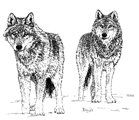Center, Internet, Wildlife Damage Management

Rocky Mountain Wolf Recovery: Annual Reports
Date of this Version
January 2007
Abstract
Before the arrival of European settlers, wolves ranged widely across the continent, from coast to coast and from Canada to Mexico. Two species are found in North America, the gray wolf, with its various subspecies, and the red wolf, found in the southeastern United States. Wolves play an important role as predators in the ecosystems they inhabit. They feed primarily on large mammals, such as deer and elk, removing sick and injured animals from the populations. Wolves are highly social, living in packs and hunting and raising young cooperatively. As the country was settled, native prey species declined and the number of domestic animals increased. As wolves increasingly turned to livestock for prey, government agencies and private citizens undertook large-scale predator control programs, with wolves hunted nearly to extinction. By the middle of the 20th century, few wolves existed in the lower 48 States. Only several hundred gray wolves in Minnesota and an isolated population on Michigan’s Isle Royale remained, along with an occasional Mexican wolf— and reports of a few red wolves. Thanks to recovery programs and to the natural migration from Canada into Montana, more than 5000 gray wolves now live in the lower 48 States. Under the Endangered Species Act gray wolf populations in the northern Rocky Mountains are listed either as endangered or as “nonessential, experimental.” Mexican gray wolves are also “nonessential, experimental,” a designation that provides management flexibility. Partners such as State wildlife agencies, universities, and conservation organizations have developed recovery plans in various parts of the country, with the goal of restoring the species to a secure status in the wild as a functioning member of its ecosystem. Recovery enables the U. S. Fish and Wildlife Service to “delist” species so that they are no longer endangered or threatened—and to return their management to States and Tribes. Recovery plans identify the population levels and distribution necessary for a species to be considered recovered. When a species reaches recovery criteria, the U.S. Fish and Wildlife Service reviews the population status to determine whether reclassification or delisting is appropriate. Recovery criteria differ among populations depending on the threats to the species, the connectivity of the populations, and local ecological circumstances. At the time of its listing under the Endangered Species Act of 1973, the gray wolf in the eastern part of the United States had been eliminated from the landscape, except in northern Minnesota and on Isle Royale, Michigan. Protection under the Act has allowed the Minnesota population to grow, and now about 3,000 wolves live there. In addition, wolves returned to Michigan’s Upper Peninsula and Wisconsin. About 900 animals live there. Because these States achieved recovery goals outlined in the Eastern Timber Wolf Recovery Plan, the U. S. Fish and Wildlife Service has removed the western Great Lakes population of gray wolves from the protection of the Endangered Species Act. States and Tribes now manage wolves in the region.


Comments
Published by U.S. Fish & Wildlife Service.